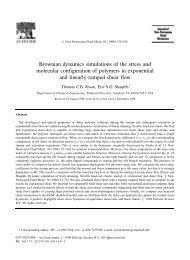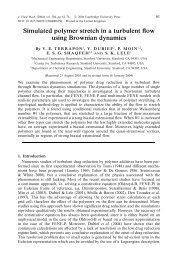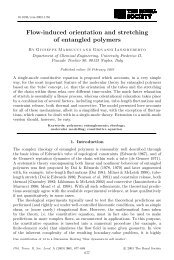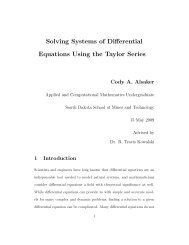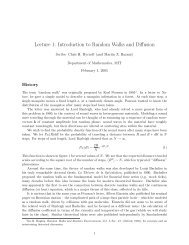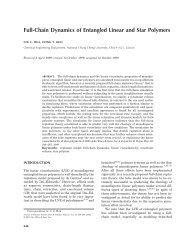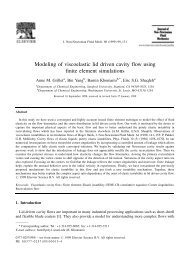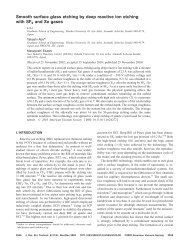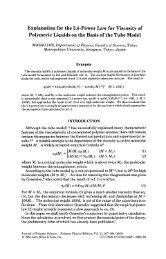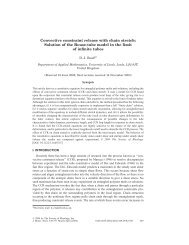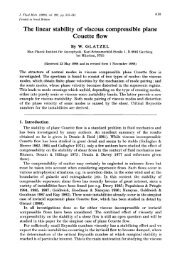180 M. B. Mackaplow and E. S. G. ShaclfehVolume fraction <strong>of</strong> fibres, p0.01 0.02 0.03 0.04 0.05I I I I In13FIGURE 10. Steady-state shear viscosity <strong>of</strong> a suspension <strong>of</strong> cylindrical fibres with aspect ratio,A = 33, relative to that <strong>of</strong> <strong>the</strong> fibre-free liquid, as a function <strong>of</strong> suspension volume fraction. Shownare <strong>the</strong> <strong>the</strong> experimentally determined values <strong>of</strong> Bibbo (1987), and <strong>the</strong> predictions <strong>of</strong> <strong>numerical</strong>simulations, <strong>the</strong> dilute <strong>the</strong>ory, and <strong>the</strong> semi-dilute <strong>the</strong>ory <strong>of</strong> Shaqfeh & Fredrickson (1990).similar orientation, and at steady state most fibres in shear are aligned in <strong>the</strong> flowdirection, such a modification to our algorithm is necessary to prevent biasing ourdistribution.In figure 10 we have compared our simulated results for <strong>the</strong> steady-state shearviscosity for <strong>suspensions</strong> <strong>of</strong> particles having aspect ratios <strong>of</strong> 33 to <strong>the</strong> predictions <strong>of</strong><strong>the</strong> dilute <strong>the</strong>ory and <strong>the</strong> semi-dilute <strong>the</strong>ory <strong>of</strong> Shaqfeh & Fredrickson (1990). Both<strong>the</strong>ories make use ( ~ 1 ~ 1 ~ = 2 ~ 0.100, 2 ) as determined from our generated orientationdistributions. For <strong>the</strong> semi-dilute <strong>the</strong>ory, since <strong>the</strong> O(1) constant has not beendetermined for this particular orientation distribution, we set it equal to zero.In figure 10 we see fairly good agreement between simulations and experiments up toconcentrations <strong>of</strong> approximately n13 = 7, above which <strong>the</strong> simulations underestimate<strong>the</strong> experimentally determined shear viscosity. Based on <strong>the</strong> previously discussedresults for isotropic <strong>suspensions</strong>, and <strong>the</strong> fact that by symmetry ( ~ 1 ~ 1 ~ = 2 ~ 0, 3 we )believe that <strong>the</strong> curved streamlines, no-slip condition on <strong>the</strong> outer wall, and shear in<strong>the</strong> (2, 3)-plane, all present in <strong>the</strong> experimental apparatus, had a negligible effect on<strong>the</strong> shear viscosity and would not account for <strong>the</strong> discrepancy between simulationand experiments.The likely sources <strong>of</strong> <strong>the</strong> discrepancy can be divided into two classes: thosewhich are equally important at all suspension concentrations and those which aremore important at higher concentrations. Concerning <strong>the</strong> former, <strong>the</strong>re are threelikely factors. First, a fibre oriented in <strong>the</strong> flow direction will make a contributionto <strong>the</strong> suspension stress tensor 0 (lnA/A2) smaller than one which is not. Since<strong>the</strong> contribution to <strong>the</strong> stress <strong>of</strong> <strong>the</strong> former is driven entirely by gradients in <strong>the</strong>undisturbed velocity along <strong>the</strong> cross-sections <strong>of</strong> <strong>the</strong> fibres, it will not be captured by<strong>the</strong> slender-body <strong>the</strong>ory approximation used in <strong>the</strong> simulations. For fibres in shearflow at steady state, only an 0(1/A) fraction <strong>of</strong> <strong>the</strong> fibres are not approximatelyaligned in <strong>the</strong> flow direction (Stover et al. 1992). Thus, <strong>the</strong> error induced by <strong>the</strong>slender-body <strong>the</strong>ory approximation in calculating <strong>the</strong> steady-state shear viscosity is
Rheological <strong>properties</strong> <strong>of</strong> <strong>suspensions</strong> <strong>of</strong> rigid, non-Brownian fibres 181O(ln A/A). This is not necessarily small for <strong>the</strong> <strong>suspensions</strong> under consideration, since(lnA)/A fi: 0.11. Secondly, when comparing <strong>suspensions</strong> <strong>of</strong> <strong>the</strong> same aspect ratio,(p1plp2p~) for our <strong>numerical</strong>ly generated <strong>suspensions</strong> was about 10% smaller than <strong>the</strong>experimentally determined values <strong>of</strong> Stover et al. (1992), due to small changes in <strong>the</strong>Jeffrey orbits induced by fibre interactions. Finally, (p1p1p2p2) in <strong>the</strong> experiments <strong>of</strong>Bibbo (1987) were probably even larger than those measured by Stover et al. (1992),since <strong>the</strong> effect <strong>of</strong> <strong>the</strong> aforementioned shear in <strong>the</strong> (2, 3)-plane would be to rotatefibres into <strong>the</strong> (1, 2)-plane.It is possible to suggest a reason for <strong>the</strong> relatively poorer agreement betweensimulations and experiments for n13 > 5. We expect <strong>the</strong> average closest approachdistance in <strong>the</strong> suspension will be between those for aligned and isotropic <strong>suspensions</strong>.However, from an analysis similar to that used by Doi & Edwards (1989), we expect<strong>the</strong> O(l/A) fraction <strong>of</strong> <strong>the</strong> fibres that are not aligned in <strong>the</strong> flow direction willexperience a closest approach distance <strong>of</strong> <strong>the</strong> same order as that in an isotropicsuspension. Since it is <strong>the</strong>se few fibres that make <strong>the</strong> dominant contribution to(c!;’), and we see a decline in <strong>the</strong> agreement between simulations and experimentsat approximately <strong>the</strong> same concentration as for isotropic <strong>suspensions</strong>, we suggest that<strong>the</strong> discrepancy is due to slender-body <strong>the</strong>ory underestimating <strong>the</strong> effects <strong>of</strong> closefibre-fibre interactions.6. ConclusionFor <strong>suspensions</strong> <strong>of</strong> rigid, non-Brownian fibres at zero Reynolds number, hydrodynamicfibre-fibre interactions have a negligible effect on <strong>the</strong> volume-averaged stresstensor for n13 < 1. At n13 - O(l), independent <strong>of</strong> any particular fibre aspect ratio orsuspension volume fraction, fibre-fibre interactions begin to enhance <strong>the</strong> stress in <strong>the</strong>suspension and it undergoes a transition to <strong>the</strong> semi-dilute regime. This transition,as well as <strong>the</strong> suspension behaviour well into <strong>the</strong> semi-dilute regime, is well predictedby dilute <strong>the</strong>ories that take into account two-body interactions. In <strong>the</strong> semi-diluteregime, <strong>the</strong> dimensionless fibre disturbance screening length, x/b, is only a function<strong>of</strong> suspension volume fraction. It is approximately <strong>the</strong> same for both aligned andisotropic <strong>suspensions</strong>, even though <strong>the</strong> latter contain many more close fibre-fibreinteractions than <strong>the</strong> former. This is in qualitative agreement with <strong>the</strong> <strong>the</strong>oreticalprediction <strong>of</strong> Shaqfeh & Fredrickson (1990), but disagrees with that <strong>of</strong> Dinh & Armstrong(1984). Our conclusion is supported by <strong>the</strong> experimental work <strong>of</strong> Bibbo (1987),who measured <strong>the</strong> zero-shear viscosity <strong>of</strong> an isotropic suspension. Bibbo (1987) hadhypo<strong>the</strong>sized that rapid alignment <strong>of</strong> <strong>the</strong> suspension caused an initially isotropicsuspension to show <strong>the</strong> same screening behaviour as that expected for an alignedsuspension, even at very short times. Our <strong>numerical</strong> simulations have shown thatpartial alignment <strong>of</strong> <strong>the</strong> suspension is not necessary for this screening behaviour tooccur. The quantitative agreement between our simulations and <strong>the</strong> semi-dilute <strong>the</strong>ory<strong>of</strong> Shaqfeh & Fredrickson (1990) can be greatly improved by adjusting <strong>the</strong> value <strong>of</strong>C” in <strong>the</strong> <strong>the</strong>ory to -1.25 and retaining <strong>the</strong> O(l/ln(l/+)) term with a coefficient <strong>of</strong>2.4. This physically corresponds to keeping classes <strong>of</strong> fibre interactions neglected by<strong>the</strong> <strong>the</strong>ory. The above result is used to show that <strong>the</strong> suspension screening lengths arevery similar to those in fibrous porous media having <strong>the</strong> same fibre volume fraction.This holds for both aligned and isotropic orientation distributions. We also directlyverify suspension screening by <strong>study</strong>ing <strong>the</strong> decay <strong>of</strong> <strong>the</strong> velocity fields created byindividual Stokeslets in fibre <strong>suspensions</strong>.



